The Road to Hāna, also known as the Hāna Highway, is a 64.4-mile-long stretch of Hawaiʻi connecting Kahului to the town of Hāna in east Maui. The Road to Hāna is characterized by its winding, narrow nature, passing over numerous bridges and curves through tropical rainforests. The journey, despite the relatively short distance, takes about 2.5 hours without any stops due to the challenging terrain.
In the sixteenth century, King Pi’ilani of Maui undertook a significant infrastructure project known as the Alaloa. The Alaloa was a road designed to connect the two main regions of Maui—West Maui and East Maui. The road was constructed using hand-fitted basalt rocks, and played a crucial role in facilitating travel and communication across the island.
The modern construction of the Road to Hāna began in the 1870s. This period coincided with the rise of the sugarcane industry in Hawaiʻi. One of the key projects associated with this era was the development of the Hämäkua Ditch. The Hämäkua Ditch was part of the East Maui Irrigation System, designed to bring water from the rainforests of Haleakalā to the semi-arid central Maui. The purpose was to provide water for the cultivation of sugarcane, which was a major economic activity.
The road construction and irrigation projects facilitated easier access to the eastern parts of Maui, where sugarcane plantations were established. Improved transportation and water supply contributed to the growth and success of the sugarcane industry.
The construction of the road to Hāna was completed, and the highway was officially opened on December 18, 1926. In August 2000, the Hāna Highway was designated as the Hāna Millennium Legacy Trail by President Bill Clinton. On June 15, 2001, the Hāna Highway was listed on the National Register of Historic Places. This recognition acknowledged the historical and cultural importance of the highway and the role it played in the development of the infrastructure on Maui.
Today, the road is a popular tourist attraction, with guidebooks dedicating sections to the journey, highlighting waterfalls, attractions, and scenic turnouts. Tourists can stop at various points to view and, in some cases, swim in the pools created by the waterfalls. Other attractions, such as botanical gardens and historical sites, are also featured.
The Road to Hāna is approximately 64.4 miles (103.6 km) long. The journey begins in Kahului and winds its way along the northeastern coast of Maui, eventually reaching the town of Hāna. While the distance may not seem extensive, the road is known for its winding nature making the drive take several hours. The road is characterized by lush landscapes, waterfalls, bridges, and breathtaking coastal views, offering a unique and memorable experience for those who embark on the journey. The drive typically takes about 2.5 to 3 hours without stops, but many visitors take their time to explore the various attractions along the way. We recommend dedicating a full day to make sure you have plenty of time and don’t feel rushed (or car sick!).
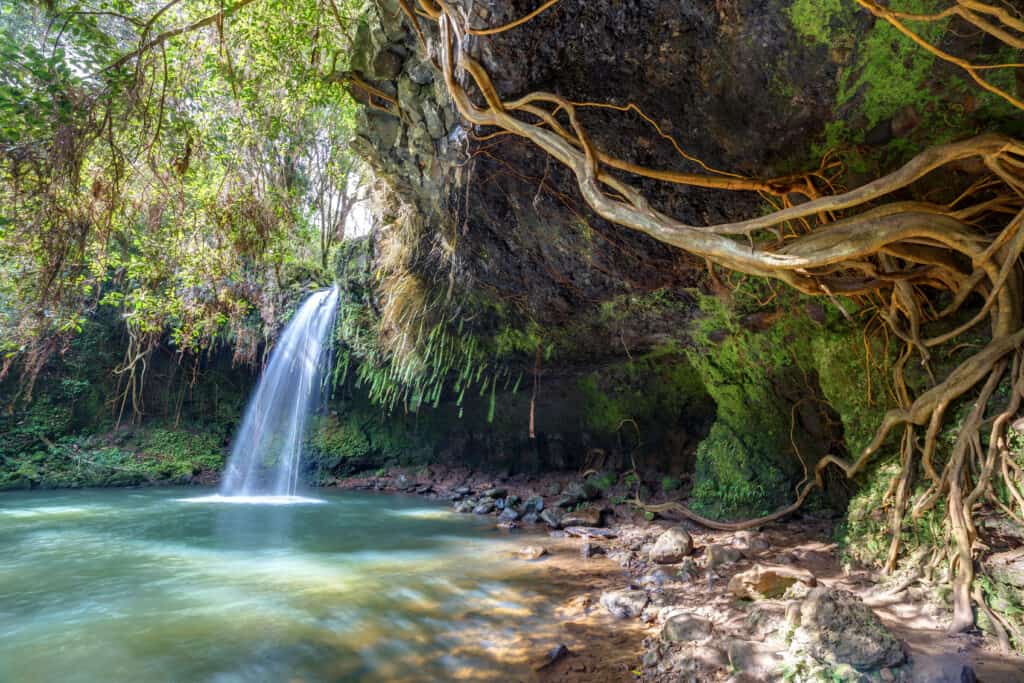
Location: Mile marker #2.1 (Hāna Hwy aka Hwy 360)
Facilities: Port-a-potties, snack stand
Parking: As of 2023, non-Hawaiʻi residents are charged $10 to park. Limited parking is available, and visitors have reported being turned away. On the first Saturday of the month, only Maui residents are admitted.
Once you set out on your journey, most travelers will make their first stop at Twin Falls located approximately 2 miles past the town of Pāʻia around mile marker 2. It’s the first easily accessible string of waterfalls and pools on the Road to Hāna. Despite being often underrated by guidebooks, it is considered a worthy stop.
Twin Falls has a main path, which is also the road for lucky residents. The parking lot may be packed, but the falls are expansive, and the site is often uncrowded even when the lot is full. The left fork leads to the popular falls known as “Caveman,” featuring a prehistoric-looking cave with vines, greenery, and a caveman swimming hole. The right fork crosses the main ditch, featuring a mini hand-dug ditch tunnel through the rock. This path leads to another set of falls with opportunities for rock-jumping.
Additional Tips:
Location: Between mile marker 4 and 5.
Hours: Everyday from 9:00 AM – 3:00 PM
Facilities: Picnic Tables and bathrooms
** This is a cash-only establishment**
The Huelo Lookout is a fruit stand with a view. This isn’t a “must see” for us but if you have the time, it’s a beautiful place to enjoy a smoothie. This fruit stand has fresh local fruit options including pineapples, papayas, starfruit, coconuts, and bananas. They also offer smoothies, shaved ice, coffee crepes, and other made-to-order food and drinks.
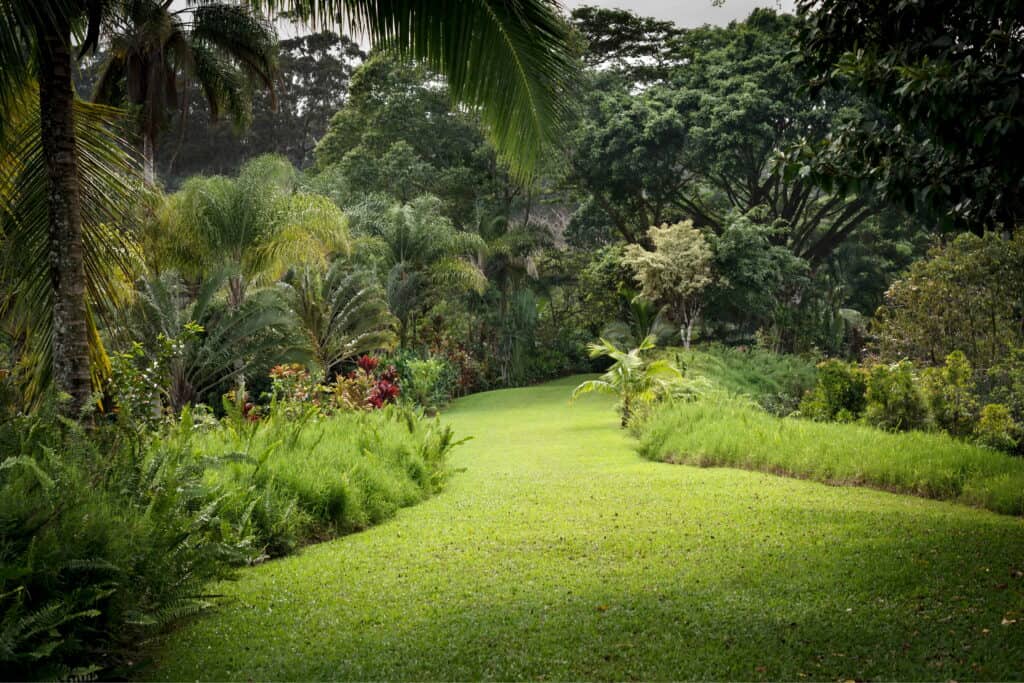
Location: On the mauka side of the Hāna Highway, half-mile past mile marker 10.
Hours: Open daily from 8:00 a.m. to 4:00 p.m.
Time Expectation: Visitors can expect to spend about an hour or two exploring the garden.
Facilities: Handicap-accessible, public restrooms, and a food truck on-site.
Admission: As of October 2021, there is an admission charge of $20 for adults, $10 for children (ages 5-16), and free admission for kids under 5.
Situated between mile markers 10 and 11, the Garden of Eden, established in 1991, celebrates Maui’s plant life and honors its natural ecosystem.Created by Alan Bradbury, Maui’s first ISA certified arborist, it is a beautifully maintained arboretum recognized by the State of Hawaiʻi for proper land use management and conservation practices. With over 700 labeled herb species, some donated by George Harrison of the Beatles, and 2.5 miles of lush walking trails, the grounds showcase a variety of tropical flora.
Visitors can enjoy a rare view of Puohokamoa Falls and explore a superb art gallery with locally made gifts. Peacocks often add to the charming ambiance. For adventurous spirits, the property also hosts Rappel Maui, a unique rainforest adventure allowing participants to rappel down jungle cliffs and Puohokamoa Falls, catering to all skill levels and being the sole tour of its kind on Maui.
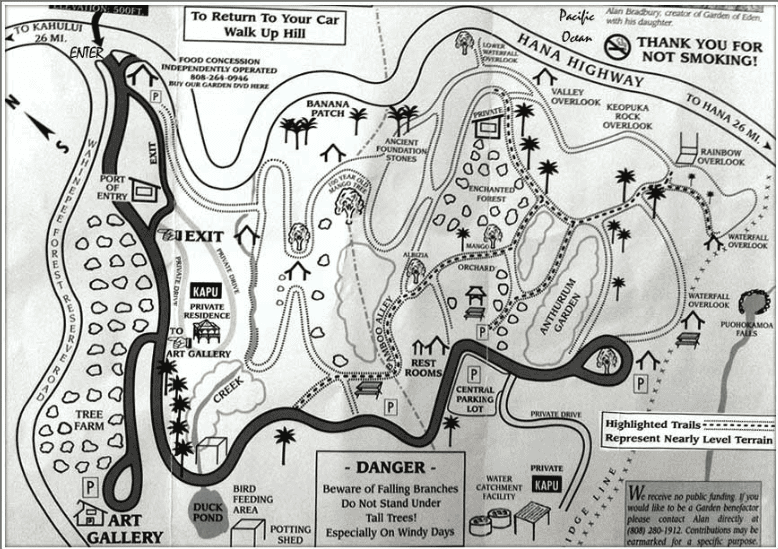
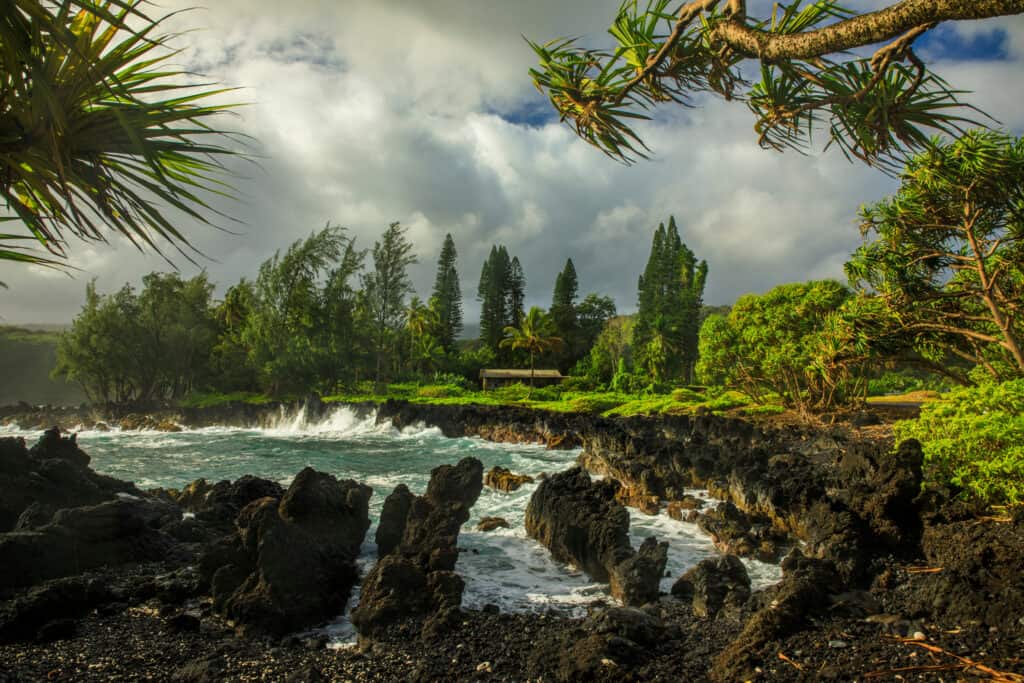
Location: Via Ke‘anae Peninsula Rd. mile marker #16.8
Facilities: No facilities available.
Ke‘anae Peninsula is a captivating old Hawaiian village situated on a lava finger offering a dramatic view along the Hāna Highway. The area is believed to have been formed by lava flows from Haleakalā, creating a dramatic and picturesque landscape. Historically, it was a taro-producing village, and much of the land is still used for taro cultivation today. This peninsula is home to the historical, Lanakila ‘Ihi’ihi O Iehowa O na Kaua Church (Sacredness, Success of Jehova, the Son of God.) Built in 1856, this church is the only building that survived the 1946 tsunami that devastated the area.
Ke’anae does not have sandy beaches, and the ocean in this area is described as rugged and dangerous. Visitors are advised against swimming here. There’s plenty of parking for travelers to get out and get spectacular photos of the landscape. It’s also highly recommended to time your travel when Aunty Sandy’s Snack Shack is open. They open at 8:30AM and are open until they sell out. Known for their banana bread and coconut candy you won’t want to miss this!
It’s also worth noting that the Ke‘anae Peninsula is a great turn around point for those who don’t want to do the full trek to Hāna or are in a time crunch.
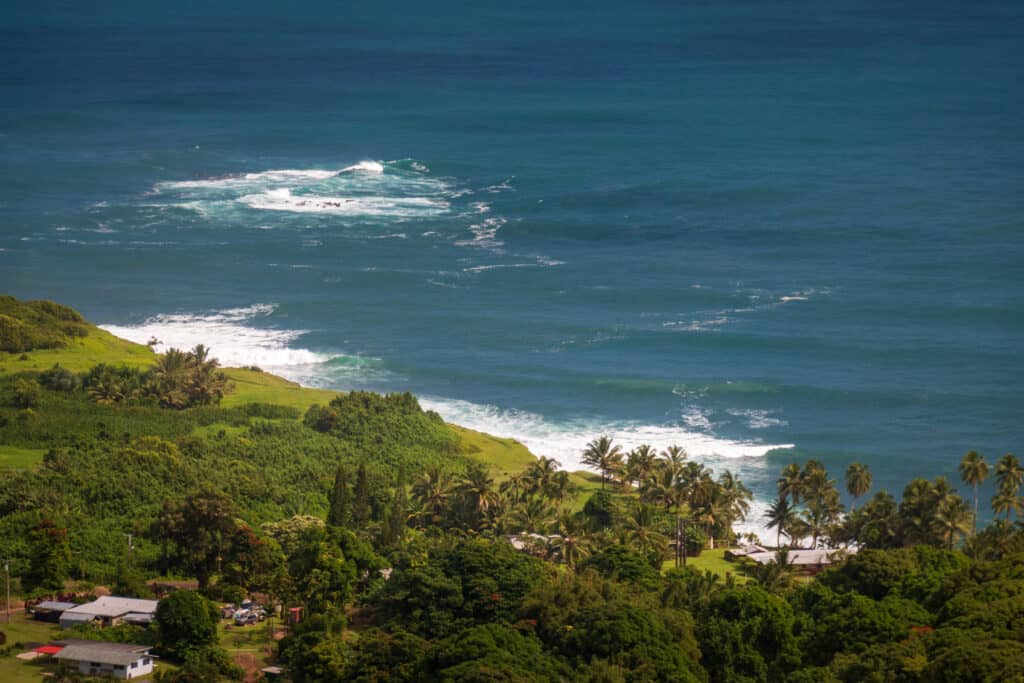
Location: This is your last view of Wailua while heading into Hāna. The pull off will be on the left hand side of the road, ¼ mile past the Wailua Valley State Wayside Park past mile market #19
Wailua Valley is an ahupuaʼa located just after the Ke‘anae peninsula. The Wailua Valley holds cultural significance, known to be home to many ancient taro patches (kalo). Due to its relative inaccessibility, Wailua Valley has been slower to undergo changes brought about by missionaries and developers. The valley has retained its natural beauty and cultural significance over the years.
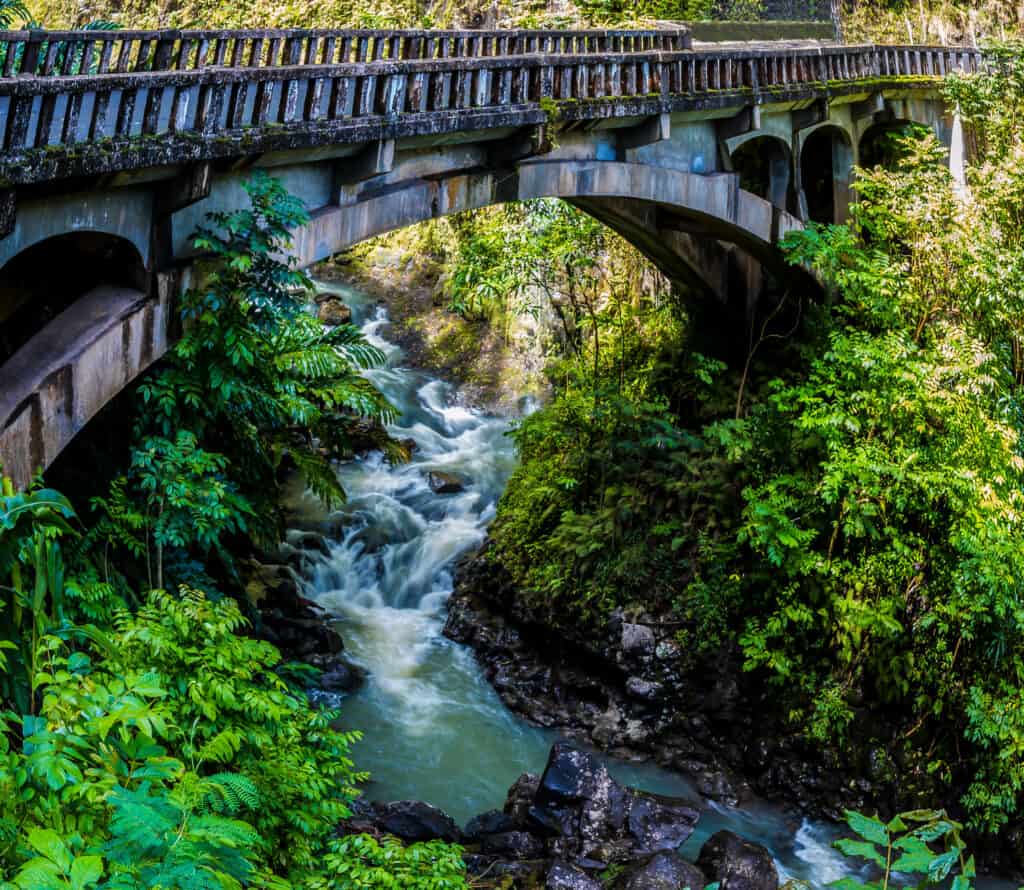
Location: Approximately around mile marker #19
Waikani Stream Bridge has been called one of the most impressive bridges on the route. Constructed in 1926 during the completion of the Hāna Highway, this bridge stands out for its unique structure—an 83-foot continuous concrete arch-deck. The single arch design contributes to the bridge’s dramatic appearance, making it a noteworthy feature.
You can view Upper Waikani Falls also known as Three Bears for its three parallel falls of varying lengths, with the smallest often referred to as the “baby bear” falls. Upper Waikani Falls cascades from a height of seventy feet into Wailua Nui Stream, making it one of the most popular waterfalls in the Hawaiian Islands.
Most visitors view Upper Waikani Falls from their cars or the bridge above it due to limited parking. For those seeking a closer experience, a moderate trail underneath the bridge leads to the crystalline waters of the falls. The trail starts steep but levels off for easy hiking, surrounded by lush jungle foliage. The area is rich in red torch ginger, ti, croton, ferns, and other tropical plants, creating an enchanting environment. You can also swim at the base of the pool beneath the falls.
Location: Mile marker #22.5
Hours: 6:00 AM – 6:00 PM
Facilities: Parking, bathrooms, wheelchair accessible, and covered picnic tables with scenic views.
Pua’a Ka’a State Wayside Park offers easy access to the falls. While not the largest, the waterfalls provide opportunities for swimming, and visitors can even go behind the falls. The basin is suitable for swimming, wading, or sitting on rocks, though caution is advised after heavy rain. The lush green surroundings, including trees and flowers, create a magical atmosphere for family pictures or picnics at the tables.
The site is wheelchair accessible, providing shaded views for those in wheelchairs. Despite occasional crowded periods, it remains a nice stop for tours and families.
Additional Tips:

Location: Mile marker #32
Facilities: Camping, cabins, picnic tables, barbecues, bathrooms, showers.
Reservations: Reservations are required for parking and day use. Visit the state park website for more information.
Famous for its black sand beach, sea caves, and the striking blue waters of the Pacific. The scenery at Waiʻānapanapa State Park is postcard-worthy and provides visitors with a true taste of Maui’s natural beauty. You can also observe the anchialine pools that are a host to native shrimp.
There is a daily visitor limit to protect the special resources of the park, including coastal views, sea arches, blow holes, and the black sand beach of Paʻiloa Bay. Visitors are required to make reservations for entry to the park. This includes both day-use visitors and those planning to stay overnight. This even extends to parking so make sure to make a reservation in advance.
Location: Mile marker #31
Hours:
Farm Stand:
Monday to Thursday: 8 am – 6 pm
Friday and Saturday: 8 am – 7 pm
Sunday: 8 am – 6 pm
The Bamboo Hale Restaurant:
Monday to Thursday: 10:30 am – 4:30 pm
Friday and Saturday: 10:30 am – 8 pm
Sunday: 11 am – 3:30 pm
Hāna Farms is THE place to eat lunch. It’s a seven-acre tropical farm, bakery, marketplace, and restaurant. Established in 1999, the farm grows organic vegetables, fruits, spices, herbs, and flowers. The roadside stand serves as a local marketplace featuring exotic produce and Hāna-made products. The bakery offers daily fresh desserts, rolls, bagels, and renowned banana bread. The Bamboo Hale Grill & Pizzeria, a walk-in restaurant, specializes in wood-fired pizza and farm-fresh plates.
Hāna Farms began with founders selling lemonade and banana bread in 2006, expanding to produce various goods in-house with locally sourced ingredients. The stand provides a space for local residents to sell art and crafts. Visitors can explore the farm-to-table process, sustainable agriculture, and local connections.
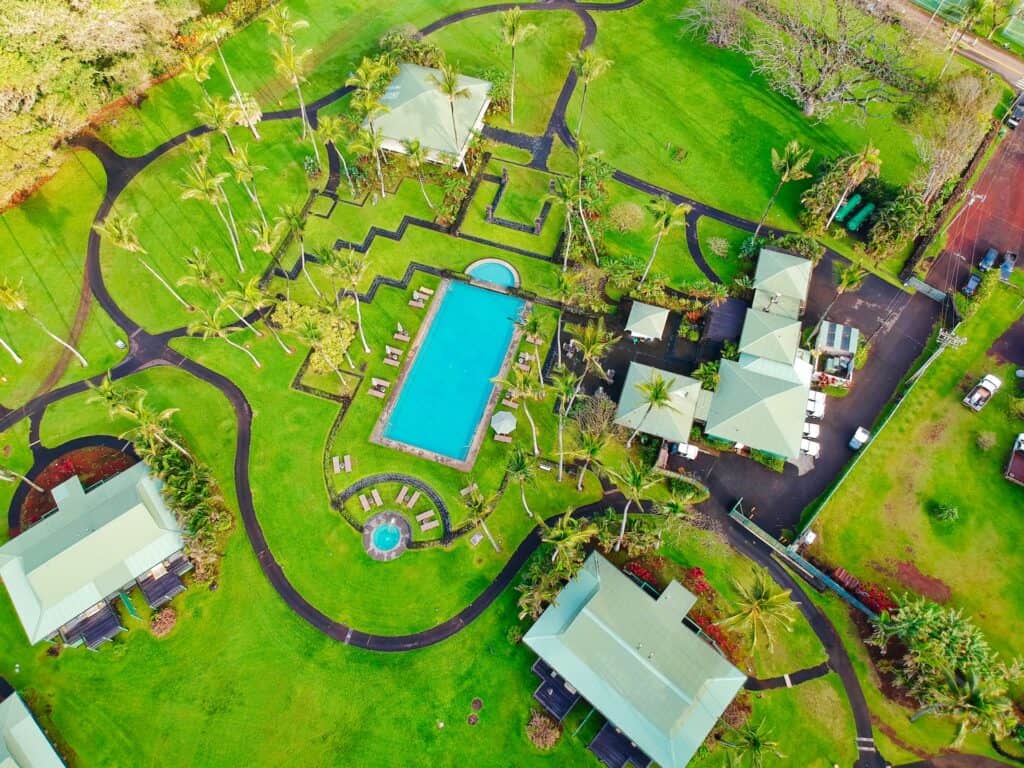
Location: Mile marker #34
Facilities: Parking, bathrooms, food, parks, beaches and museums
Hāna offers a glimpse into old Hawaiʻi with its rural charm, it’s often considered the epitome of “real Hawaiʻi” due to its preservation and lack of development compared to other parts of the island. You can relax and swim at Hāna Beach Park, learn about the rich history and culture of Hāna at the cultural center and museum, or enjoy a chili rice bowl at the Hāna Ranch Store. Appreciate the quiet streets and local architecture that Hāna is known for.
Hāna Town is not only a place to recharge during your journey along the Road to Hāna but also an opportunity to immerse yourself in the real and untouched Hawaiʻi. Many people think this is the ultimate destination on the Road to Hāna but we encourage you to explore past the town of Hāna because there’s more beaches and waterfalls just ahead.

Location: mile marker #42
Facilities: National Park Rangers, Information Facility, Camping (no add’l fee/no permit req’d), grills, picnic tables and bathrooms. No potable water is available in the park.
Admission: $15/car – NPS Info
The Pools of ‘Ohe’o, also known as the Seven Sacred Pools, stand as East Maui’s most popular attraction, featuring beautiful waterfalls and pools set in a stunning rainforest setting. The site offers easy access and National Park Service (NPS) facilities. However, it tends to get crowded later in the day, and access to pools may be closed during wet weather.
the pools are typically accessible, well-suited for swimming and cliff-jumping. They get crowded, especially in the afternoon. Tips for minimizing crowds include arriving before noon, staying along the Road to Hāna, or starting early via the back side of Haleakalā.
It’s also home to the Pipiwai Trail, a 4 mile round trip, moderately challenging hike. It’s a well defined trail that takes hikers through a mesmerizing bamboo forest, past waterfalls and ultimately leads you to Waimoku Falls. While the distance may not be extensive, the trail’s terrain and elevation gain contribute to the moderate difficulty level. Hikers should allocate a few hours for the round-trip journey, allowing time to enjoy the scenic beauty along the way and at the destination. The estimated hiking time is typically between 2.5 to 5 hours, depending on the individual’s pace and the amount of time spent exploring the sights.
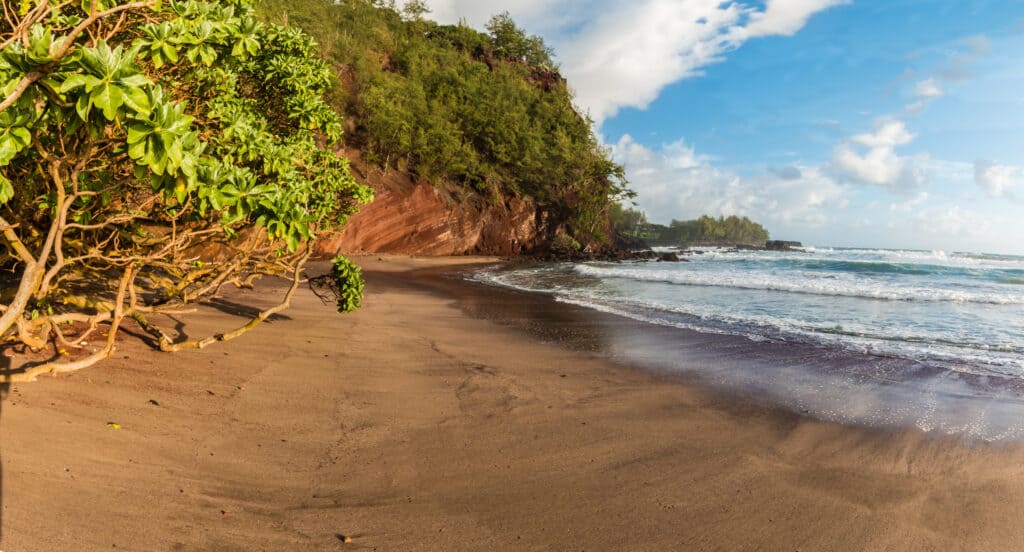
Location: Mile marker #45
Facilities: Public bathrooms and showers, foot washing station, Picnic tables
Parking: Street parking
Both Koki Beach and Hamoa Beach offer unique experiences, and visitors can choose between them based on their preferences. Both provide a refreshing stop on your journey.
Koki Beach is known for its dark red sand, which is associated with Hawaiian legend. According to legend, Koki Beach is where the volcano goddess Pele fought her final battle with her older sister, Namakaokaha’i, the goddess of the ocean. Pele’s bones were believed to be stacked along the Koki shoreline, and her spirit traveled to Kīlauea of Big Island.
Koki Beach is renowned as one of the two famous Hāna surf breaks and is a favorite spot for local surfers. However, it’s emphasized that swimming is not recommended, and only experienced surfers are advised to go out at this spot. The beach is known for its steep waves, and in the winter, the water can be more violent. For those looking to swim, Hamoa Beach, located less than a mile away, is suggested as a safer option. The walk to Hamoa Beach may have steep sections, and parking may be limited.
Hamoa Beach is known for its stunning crescent-shaped beach lined with Hala trees. The scenery is picturesque and offers a more traditional white sandy beach compared to Koki Beach. The beach features silky sand that runs into the ocean, providing a comfortable setting for beachgoers. The water is usually pristine and sparkling, making it an inviting spot for swimming.

Location: Mile marker #45
Facilities: Port-a-potties, snack stand
Parking: Ample parking
Wailua Falls is located just past mile marker #45 on Honolewa Stream (not Wailua Stream). With a height of approximately eighty feet it’s renowned as Maui’s “most photographed waterfall”.
Unlike some waterfalls that require hiking, Wailua Falls is conveniently visible from the road, allowing visitors to enjoy its beauty without leaving their cars. Situated near Koki Beach and Hamoa Beach, it provides an excellent opportunity for travelers to relax and explore nearby attractions before reaching the Seven Sacred Pools (‘Ohe’o Gulch) at Kīpahulu in Haleakalā National Park.
While most people stay near the roadway, adventurous travelers can embark on a quick, albeit potentially slippery, walk down to the plunge pool. The pool offers a chance for a refreshing swim, breathtaking views, and a serene natural environment.
Additional Tips:
As always remember to Mālama (to care for) Maui’s environment & local culture by:
Stick to designated paths and walkways to avoid trampling on dune vegetation
We recommend starting early in the day to avoid crowds and make the most of your time. The road can be busy, especially later in the morning. Research and plan your stops in advance. The reality is that you won’t hit everything so prioritize the ones you’d like to visit.
Make sure to bring cash, as a lot of the business are cash only, fill up your gas tank and pack essentials such as water, snacks, sunscreen and insect repellent. Services along the road can be limited, so it’s wise to be prepared.
Most importantly, enjoy the journey. The Road to Hāna is not just about the destination; it’s about the journey. Take your time, enjoy the breathtaking scenery, and immerse yourself in the beauty of Maui.
Immerse Yourself in our SEA-News featuring Hawaiʻi’s marine life, inspirational conservation, and glimpses behind-the-scenes.
Immerse Yourself in our SEA-News featuring Hawaiʻi’s marine life, inspirational conservation, and glimpses behind-the-scenes.

